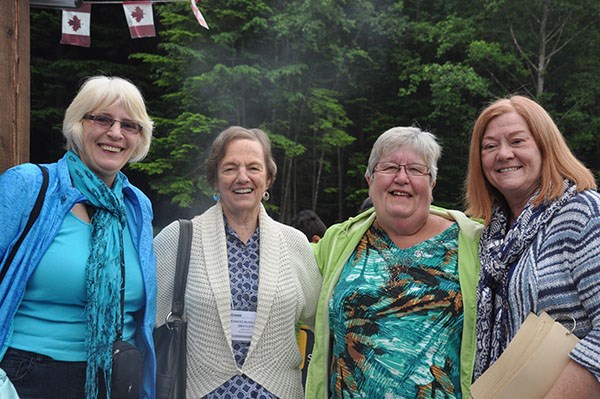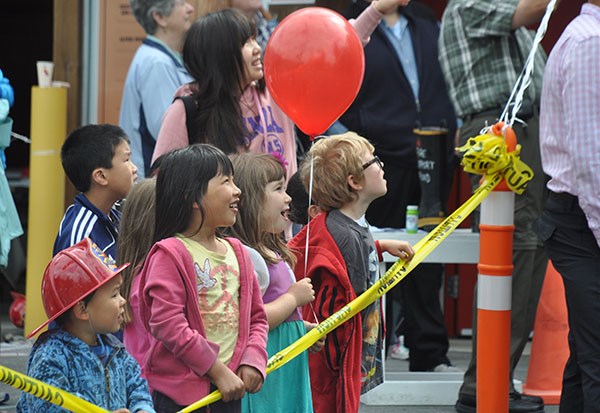∞’≥Û±Ã˝boom-and-bust cycles of the mining industry being what they were, John and Alice Graney had to move their family around a number of times from the 1930s to the 1960s ‚Äî to Wells, Hope, etc. ‚Äî to make ends meet.
But Linda Graney-Harvey, one of the couple’s three children, always considered Mount Sheer — one of two residential communities that housed those who worked at the Britannia Mine — home. In fact, in Graney-Harvey’s memory, the now-defunct community southwest from the current village of Britannia Beach was “utopia.”
Perhaps that’s because of the strong feeling of community that Frances McKilligan and Elsa Harvey — two of the approximately 100 former residents of Britannia Beach and Mount Sheer who returned last weekend for the Britannia Mine Museum’s 110th anniversary “homecoming” — said existed back then.
And it wasn’t just the families who felt that closeness, Harvey said.
“Miners are a close breed of brothers, and they looked out for each other,” she said. “I think camaraderie was a big part of the community. I think when you work in such close situations, you have to stick together.”
McKilligan, whose parents met at Mount Sheer — he was a miner and she cooked in the bunkhouses where the single men lived — agreed.
“It was just a wonderful place to be brought up in,” said McKilligan, whose father Frank Bentley worked his way up to being a foreman in the Victoria shaft of the copper mine. “Nobody locked their doors and everybody looked after everybody’s children.”
The Britannia Mine opened in 1904. That same year, the Britannia Beach Mining and Smelting Co. founded the community‚Äôs volunteer fire department. Hence, the Britannia Mine Museum and Britannia Beach Volunteer Fire Department (VFD) celebrated the twin 110th anniversaries this past weekend.¬Ý
The museum staged a three-day “homecoming” event that includes the Celebrating 110 Years Photo Exhibit and an invitation for anyone who used to work or live in the community to gather and share stories, photos and memories.
Sunday’s (June 29) Britannia Beach VFD 110th anniversary included a pancake breakfast served up by firefighters, public fire suppression and auto-extrication demonstrations, balloons and face painting for the kids, and a chance to see the department’s own museum piece — a 1951 Bickle fire engine that was recently taken out of storage in preparation for restoration work to be undertaken by Vancouver Community College, Chief Steve Virgint said. The recent addition to the hall to accommodate the vintage engine was all completed through fundraising. Virgint offered a big thanks to volunteer firefighter Tony Paquette for having co-ordinated the project.
Among the oldtimers who showed up for Sunday’s festivities at the fire hall, a lot of the talk was about life in Mount Sheer. During the mine’s heyday in the 1920s and ’30s, Mount Sheer and Britannia both had populations of close to 3,000, said Kirsten Clausen, the museum’s executive director.
McKilligan, who lived in Mount Sheer from 1938 to 1955, said it was an arduous trek to reach Mount Sheer ‚Äî¬Ýone had to climb 345 steps, walk up a steep slope for 15 minutes and then board an electrified, narrow-gauge platform called a ‚Äúskip‚Äù for the final couple of kilometres‚Äô journey.
“Everything that people had had to go up that incline,” McKilligan said. “We had a piano in our house, and that piano had to go up that incline and on the platform to make the trip.”
Mount Sheer had about 100 homes as well as three bunkhouses where the single men who worked at the mine stayed. The community was a vibrant one — it had its own swimming pool and gymnasium with the full range of equipment, and also included a 10-bed hospital.
“Dad was mine foreman for the Victoria area of the mine,” McKilligan said. “He was in the First World War in England, came out in the 1920s and got a job there. It would have been around 1923. At that time Britannia was the largest copper mine in the Commonwealth.”
Those in the two communities had their own celebrations of Halloween and Dominion Day (later Canada Day), their own bands and even two churches — the United and the Catholic, which were housed in the same building in Britannia Beach. The two even had separate sports teams that were “quite competitive” with each other, McKilligan said.
McKillgan, who was an only child, recalls that her family often shared Christmas and New Year’s with the Allen family — Leonard Allen was the mine superintendent when it closed down in 1974.
“From Vancouver to Britannia Beach was three hours,” McKilligan said. “If you had company, if they could climb the stairs and get there, they would always stay overnight.”
Will Trythall, who lived in Mount Sheer after the Second World War, said his family had a one-bedroom home in which his bedroom was essentially the back porch. Otherwise, though, life was pretty good.
“As kids, we were spoiled with all the recreation we had up at the townsite, and the schooling was good,” he said. “It was a five-room school with grades in various rooms — if you were in Grade 6, you were in with the 7s and 8s and you couldn’t help but find out something about what the other kids were learning.”
For mining purposes, everything was measured in reverse elevations in feet, Trythall said. The top of Mount Sheer itself was the 0 level; Mount Sheer townsite was 2200 level and the village of Britannia Beach ‚Äî sea level ‚Äî was at 4300.¬Ý
Things started to change a bit when the first road linking Britannia Beach to the outside world went through, Trythall said.
‚ÄúIn 1948 when the road went through to ¿œ∞ƒ√≈¡˘∫œ≤ ø™Ω±º«¬º◊ ¡œ, I think the Beach changed because instead of having a house party with their neighbours, they could jump in the car and drive up to the pub in ¿œ∞ƒ√≈¡˘∫œ≤ ø™Ω±º«¬º◊ ¡œ,‚Äù he said.
The mine company shut down the Mount Sheer townsite in 1958. In the mid-1960s, it was deemed necessary to burn down all the buildings after squatters started to take up residence there, Clausen said.
Museum officials were extremely pleased with the turnout at last weekend’s homecoming celebration, she said.
“The town and the stories of the people who lived there are an important piece of B.C.’s history, and we wanted to honour that.”
The 110th anniversary displays and other festivities continue at the museum. For details, visit www.britanniaminemuseum.ca.





